

Author's Note. The Teenage Brain Explained. Brain Development in Teenagers. Why Are Teens So Moody? Helping your child through early adolescence. Getting along with your teenagers. Parenting Tips for your teenager. Summary of Reinforcement. Reinforcement and Punishment (Positive and Negative) - Examples and Explanation. Reinforcement. A consequence applied that will strengthen an organism's future behavior Using a Skinner box to alter the subject rat's behaviour Reinforcement is an important part of operant or instrumental conditioning.
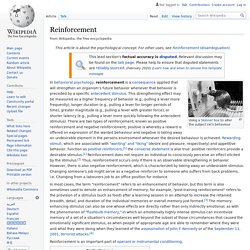
Terminology[edit] In the behavioral sciences, the terms "positive" and "negative" refer when used in their strict technical sense to the nature of the action performed by the conditioner rather than to the responding operant's evaluation of that action and its consequence(s). "Positive" actions are those that add a factor, be it pleasant or unpleasant, to the environment, whereas "negative" actions are those that remove or withhold from the environment a factor of either type. Introduction[edit] B.F. The sole criterion that determines if a stimulus is reinforcing is the change in probability of a behavior after administration of that potential reinforcer. Brief history[edit] Operant conditioning[edit] The term operant conditioning was introduced by B.
What Is Reinforcement in Operant Conditioning? One of the many different ways in which people can learn is through a process known as operant conditioning (also known as instrumental conditioning).1 This involves learning through reinforcement or punishment.

The type of reinforcement used can play an important role in how quickly a behavior is learned and the overall strength of the resulting response. Understanding Reinforcement Reinforcement is a term used in operant conditioning to refer to anything that increases the likelihood that a response will occur. Psychologist B.F. Skinner is considered the father of this theory. For example, reinforcement might involve presenting praise (the reinforcer) immediately after a child puts away her toys (the response). Reinforcement can include anything that strengthens or increases a behavior, including specific tangible rewards, events, and situations.
Positive Reinforcement. The power of positive re-inforcement. Why Does Positive Reinforcement Work? Parenting A Teen Through Positive Reinforcement - Back On Track. Most parents can agree: the teenage years can be rough!
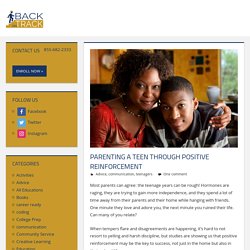
Hormones are raging, they are trying to gain more independence, and they spend a lot of time away from their parents and their home while hanging with friends. One minute they love and adore you, the next minute you ruined their life. Can many of you relate? When tempers flare and disagreements are happening, it’s hard to not resort to yelling and harsh discipline, but studies are showing us that positive reinforcement may be the key to success, not just in the home but also in their school life. We’ve all heard the saying, “The one who is hardest to love needs love the most.” As a student at My Virtual Academy, your teen will have weekly interaction with their teachers and mentors. In regards to school, if you notice your student is struggling, take a different approach and instead of getting mad or grounding your teen, commend them on something that you noticed they did well.
Negative Reinforcement: What Is It and How Does It Work? What is negative reinforcement?

Negative reinforcement is a method that can be used to help teach specific behaviors. With negative reinforcement, something uncomfortable or otherwise unpleasant is taken away in response to a stimulus. Over time, the target behavior should increase with the expectation that the unpleasant thing will be taken away. Example of Negative Reinforcement. 7 Examples of Positive Reinforcement in Everyday Situations. Positive reinforcement is a highly recommended concept that is grounded in behavioral psychology and is used regularly within applied behavior analysis services.
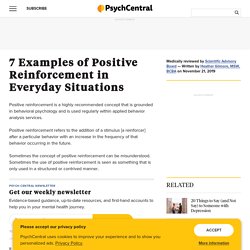
Positive reinforcement refers to the addition of a stimulus [a reinforcer] after a particular behavior with an increase in the frequency of that behavior occurring in the future. Sometimes the concept of positive reinforcement can be misunderstood. Sometimes the use of positive reinforcement is seen as something that is only used in a structured or contrived manner. It is important to remember that positive reinforcement occurs often in everyday situations for all people. Let’s go over examples of how positive reinforcement is present within common situations (with the assumption that the behavior that was the focus of the example occurs more often in the future). Parenting Children with Positive Reinforcement (Examples + Charts)
Children don’t come with instructions and discipline is often experienced by parents and children alike as an arena where our will and wits are tested.

Positive Reinforcement - Tips for teaching and parenting. How to Use Positive Reinforcement for Positive Behaviors. How to Reward Your Teen for Good Behavior. Teenagers are young adults who are trying to learn the ways of the world.
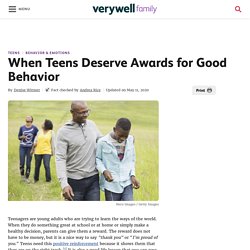
Summary of Punishment. Positive Punishment: What It Is, Benefits, and Examples. Positive punishment is a form of behavior modification.
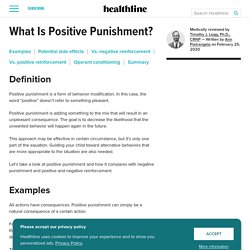
In this case, the word “positive” doesn’t refer to something pleasant. Positive punishment is adding something to the mix that will result in an unpleasant consequence. The goal is to decrease the likelihood that the unwanted behavior will happen again in the future. This approach may be effective in certain circumstance, but it’s only one part of the equation. Guiding your child toward alternative behaviors that are more appropriate to the situation are also needed. How Negative Punishment Works. Negative punishment is an important concept in B.

F. Skinner's theory of operant conditioning. In behavioral psychology, the goal of punishment is to decrease unwanted behavior. In the case of negative punishment, it involves taking something good or desirable away to reduce the occurrence of a particular behavior. 12 Examples of Positive Punishment & Negative Reinforcement. You might be thinking that “positive punishment” sounds like an oxymoron, after all, how can punishment be positive?

Not many people “like” punishment, right? The disconnect in understanding this concept comes from the usage of the word “positive;” here at PositivePsychology.com, we generally use the term “positive” to refer to things that are inherently good, things that are life-giving, and things that promote thriving and flourishing. The concept of positive punishment comes from a very different era and a very different perspective on psychology; namely, the 1930s and behaviorism. So, what actually is positive punishment and how does it relate to parenting, teaching, and even the workplace? Before you read on, we thought you might like to download our 3 Positive Psychology Exercises for free.
You can download the free PDF here. Teen Bad Behavior & Discipline Plans - Promoting Healthy Growth Ages 15 - 18. Bad behavior doesn't end when your child graduates from diapers -- or even from middle school. In fact, the teen years can bring some of the toughest discipline challenges parents have to face. Sulking, arguing, lying, and rebelling are just a few of the ways teens misbehave. There's a good explanation for these bad behaviors. As teens become more independent, they still lack the emotional maturity they need to make informed, thoughtful decisions. The parts of the brain that control decision making and impulse control haven't fully developed.
You want your children to do the right things, but disciplining teens isn't easy. The goal of discipline is to gain more control over your kids -- without being too controlling. Negative reinforcement: Definition and examples. Negative reinforcement encourages specific behaviors by removing or avoiding negative consequences or stimuli. It is different than punishment, which aims to discourage a specific behavior. Negative reinforcement has become a popular way of encouraging good behavior at school. Keep reading to learn more about how it works and how it differs from positive reinforcement and punishment.
Negative reinforcement is the encouragement of certain behaviors by removing or avoiding a negative outcome or stimuli. People typically use this technique to help children learn good patterns of behavior, but it can also play a role in training animals and pets. 10 Positive Punishment Techniques & Their Effect. By: Ashley Brown Updated February 11, 2021 Medically Reviewed By: Laura Angers As a parent, it is natural to wonder about the best way to teach your child right from wrong. Punishing them is no fun, but sometimes it has to be done if you want their behavior to change. Not everyone will agree on how you should punish your child, but some experts are convinced that positive punishment techniques are the best approach.
Negative Punishment Examples and Scenarios. Nobody ever wants their stuff taken away. That is the main concept behind negative punishment. Using negative punishment example scenarios, gain an understanding of the concept and its effectiveness. Then, go on to explore the difference between positive and negative punishment.
Psychology: Reinforcement and Punishment. Difference Between Positive and Negative Reinforcement. Why Negative Reinforcement Works Better as Your Child Grows into A Teen. If you are someone who has always loved the freedom of “no strings attached”, the idea of marrying and having kids could be quite underwhelming. The idea of having a family always used to bug me, until I finally found the love of my life. It's when I categorically made up my mind about what I wanted from our marriage. I wanted kids, I was clear about that, but I wasn’t certain how I would be taking care of them. The Outgrow of Parenting Fears and My Redemption A year after my marriage, I got pregnant with a baby boy. The hormonal changes were intense during the pregnancy, and again, I started overthinking about how I would be raising him. When I was in the 24th month of my pregnancy, I started staying emotionally distressed about how I would be dealing with my toddler's late night tantrum and smelly diapers (honestly, I don't feel the same now), or his aggression when he'll grow into a preteen.
Positive Punishment. Positive Punishment Checklist. Positive vs. Negative Reinforcement: A Guide for Parents – Generation Mindful. I almost stopped bringing them to the playground. With two children under the age of 4, playgrounds had been a place of respite for me. I could sit on the bench and catch up with some parent friends while my littles jumped, slid, and climbed to their heart's content in a controlled setting. We could all let off a little steam there, but leaving the playground had become such a process that I almost stopped going altogether. Inevitably, when I announced it was time to go, my 3-year-old would run away. Laughing maniacally, he’d climb a slide or shimmy to the top of a play structure and gleefully gaze down at me as though it was a joke, as though dinner didn’t need to be made and naps didn’t need to happen. Meanwhile my 2-year-old would cry. Executing a graceful playground exit is apparently one of the finer arts of parenting, and clearly one I hadn’t mastered.
None of those felt quite right.